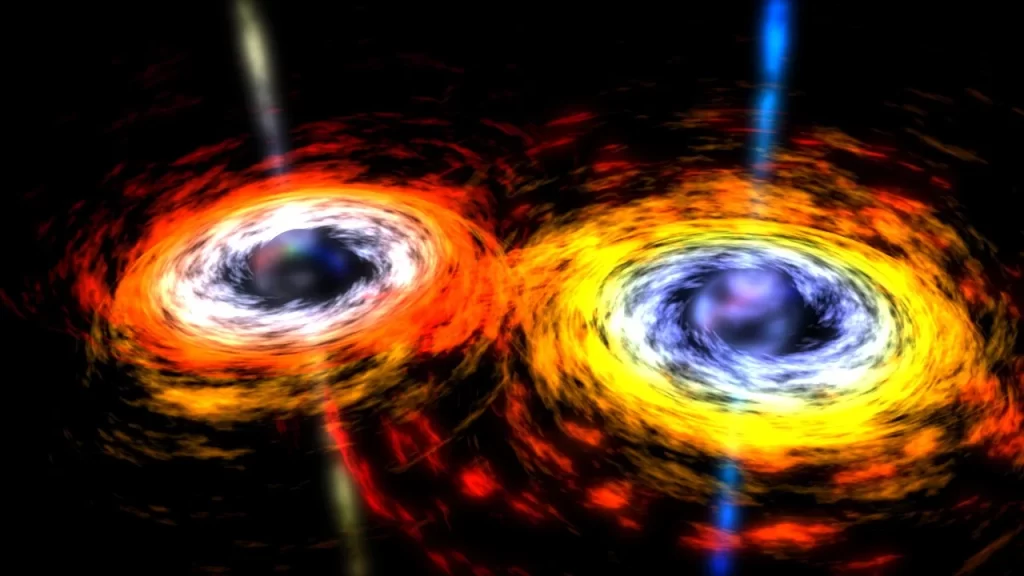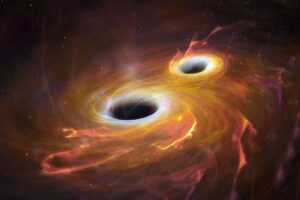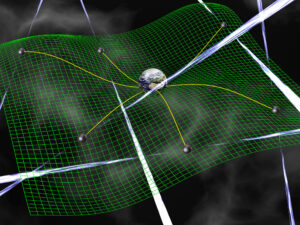LIGO Detects Merging Ripples in Space and Time

LIGO Detects Merging Ripples in Space and Time
The Laser Interferometer Gravitational-wave Observatory (LIGO) has made a 3rd detection of gravitational waves, ripples in area and time, demonstrating that a brand new window in astronomy has been firmly opened. As changed into the case with the primary detections, the waves have been generated whilst black holes collided to shape a bigger black hollow.
The collision of a couple of colossal, stellar-mass black holes has made itself heard, almost three billion mild years away, via a cosmic microphone on Earth.
On January 4, the Laser Interferometry Gravitational-wave Observatory (LIGO) picked up a slightly perceptible sign that scientists quick decided to be a gravitational wave — a ripple of power passing via the curvature of spacetime. The occasion, posted nowadays in Physical Review Letters, marks the 0.33 direct detection of a gravitational wave.
Catalogued as GW170104, the sign, whilst translated into the audio band, resembles an upward-sweeping chirp, function of a “binary coalescence,” or a merging of huge astrophysical items withinside the remote universe. The group has concluded that the gravitational wave changed into produced through the collision of heavy, stellar–mass black holes, one expected to be approximately 31 instances, and the opposite 19 instances, as huge because the sun.
The sign captured through LIGO lasts much less than -tenths of a 2nd, and in that fraction of a moment, scientists calculate that the black holes whirled round every different approximately six instances earlier than merging into one giant, 49-solar-mass black hollow. This cosmic collision gave off an significant quantity of power withinside the shape of gravitational waves, equal to 2 instances the mass of the sun.
The merger came about approximately three billion mild years from Earth, measuring approximately two times as some distance because the black hollow collision that produced GW150914, LIGO’s first-ever gravitational wave detection.
“This is certainly the farthest out stellar-mass black hollow gadget anybody has visible,” says Erik Katsavounidis, senior studies scientist in MIT’s Kavli Institute for Astrophysics and Space Research and a member of the LIGO group.
A mathematical calculation of the warped spacetime close to merging black holes. The simulation is constant with LIGO’s remark of the occasion dubbed GW170104. The coloured bands are gravitational-wave peaks and troughs, with the colours getting brighter because the wave amplitude increases. The throats close to the middle of the film suggest the sturdy spacetime warping close to the black holes’ occasion horizons. Credit: SXS Collaboration.
Out of alignment
The new gravitational wave sign is just like LIGO’s first detections, each in its source — a binary black hollow merger — and the general mass of that source.
However, the scientists determined an thrilling function withinside the most recent sign: The spin of at the least one of the black holes can also additionally had been “antialigned” with the orbital angular momentum — the course wherein the black holes have been orbiting every different. This phenomenon might be just like teacups spinning counterclockwise on a clockwise-rotating carnival platform.
Katsavounidis stresses that the symptoms and symptoms for antialignment are small, aleven though probably significant. If scientists stumble on extra antialigned structures, such proof can also additionally help a formation state of affairs referred to as dynamical seize, wherein black holes evolve one by one in a cosmic surroundings cluttered with stellar items. In such an surroundings, black holes with diverse spins can in the end pair up in binary structures, surely via gravitational, “dynamic” attraction.
Dynamical seize runs counter to a version called “not unusualplace envelope evolution,” wherein binary black holes evolve together, with spins which can be aligned with their orbital angular momentum. In fact, the LIGO group inferred that the December 2015 detection had a sturdy possibility of aligned spins, opposite to this most recent sign.
“Here for the primary time, we’re seeing antialignment is favored,” Katsavounidis says. “If we are able to stumble on extra structures, we are able to nail down beneathneath what instances black holes fashioned and developed to shape binary structures that in the long run merged.”
Real-time serendipity
After present process tune-ups to enhance its sensitivity, LIGO commenced its 2nd gazing run on November 30, 2016. Katsavounidis says GW170104’s detection had “a sure component of serendipity.”
On January 4, 2017, at 10:11:58.6 UTC, a gravitational ripple changed into recorded passing via certainly considered one among LIGO’s detectors, in Hanford, Washington. Three milliseconds later it handed via the dual detector extra than three,000 kilometers away in Livingston, Louisiana. The ripple triggered every detector to alternately amplify and reduce ever so slightly, producing a small wiggle withinside the statistics amassed through each detectors.
Within tens of seconds, LIGO’s seek algorithms robotically analyzed the sign, evaluating it to waveforms function of gravitational waves.
“A very cautious researcher in Germany changed into searching on the statistics as they have been coming in, and observed one of the detectors picked up some thing significant,” Katsavounidis says. “That occasion changed into diagnosed in close to-actual time, way to that colleague.”
The researcher right now notified LIGO’s detector operations, characterization, and statistics evaluation running groups, which started working similarly dissecting the sign. The scientists used computational equipment to slim in on a possible set of parameters, which include a gadget’s mass, spin, and orientation, that might produce a gravitational sign matching the only visible withinside the statistics.
The pleasant match became out to be a couple of merging black holes, which the scientists calculated to be the second one maximum huge stellar-mass binary black hollow gadget, in the back of GW150914, LIGO’s first gravitational wave detection.
Fighting gravitational fuzziness
With this new detection, the group once more showed Albert Einstein’s principle of widespread relativity, gazing that the conduct of the merging black holes agreed with Einstein’s predictions of gravitational effects, even at such excessive scales.
“That’s an tremendous thing,” Katsavounidis says. “Whether you speak approximately gravity on Earth, or some thing in which the gravitational ability is a thousand million instances greater, widespread relativity nevertheless describes how the ones gravitational waves are generated and the way the ones items behave gravitationally.”
As a part of the preliminary evaluation of the sign, LIGO researchers produced “sky maps” with approximate regions withinside the sky for in which the binary black hollow gadget is probably positioned. As a part of its wellknown procedure, LIGO despatched those sky maps out to approximately eighty companion astronomy groups, every of which has get admission to to imaging equipment that span the complete electromagnetic spectrum, in addition to neutrinos. While LIGO keeps to pay attention for symptoms and symptoms of different excessive activities withinside the universe, astronomers had been pointing their telescopes withinside the course of GW170104’s source, hoping to peer glimmers of the colliding black holes.
“LIGO acts as our ears, so as to speak, and we need to pay attention for some thing and quick pass our eyes to observe the sign,” Katsavounidis says. “Our project is to combat the fuzziness of gravitational wave detectors through including extra of them withinside the international network, and through pairing [the detections] with mild as quickly as possible.”
The look for gravitational waves will quickly advantage a further set of ears, withinside the shape of Virgo, a comparable detector positioned close to Pisa, Italy, this is scheduled to return back on line this summer time season and could pair with LIGO.
“Coming from a discipline of searching out some thing rare, I’ve continually been hesitant, with one detection only, to claim victory,” Katsavounidis says. “I can let you know I’ve commenced napping tons higher after the second one detection. Now this 0.33 one solidifies LIGO and LIGO’s observations because the last device to peer the mass spectrum of black holes in our universe.”
“With the 0.33 showed detection of gravitational waves from the collision of black holes, LIGO is organising itself as a effective observatory for revealing the darkish aspect of the universe,” says David Reitze of Caltech, government director of the LIGO Laboratory. “While LIGO is uniquely proper to gazing those forms of activities, we are hoping to peer different forms of astrophysical activities quickly, which include the violent collision of neutron stars.”
This studies changed into supported, in part, through the National Science Foundation.
![Hubble Finds “Missing Link” Black Hole Tearing Apart a Star That Passed Too Close [Video]](https://aspiredworlds.com/wp-content/uploads/2022/07/Mid-Sized-Black-Hole-Eating-Star-scaled-1-300x169.jpg)






